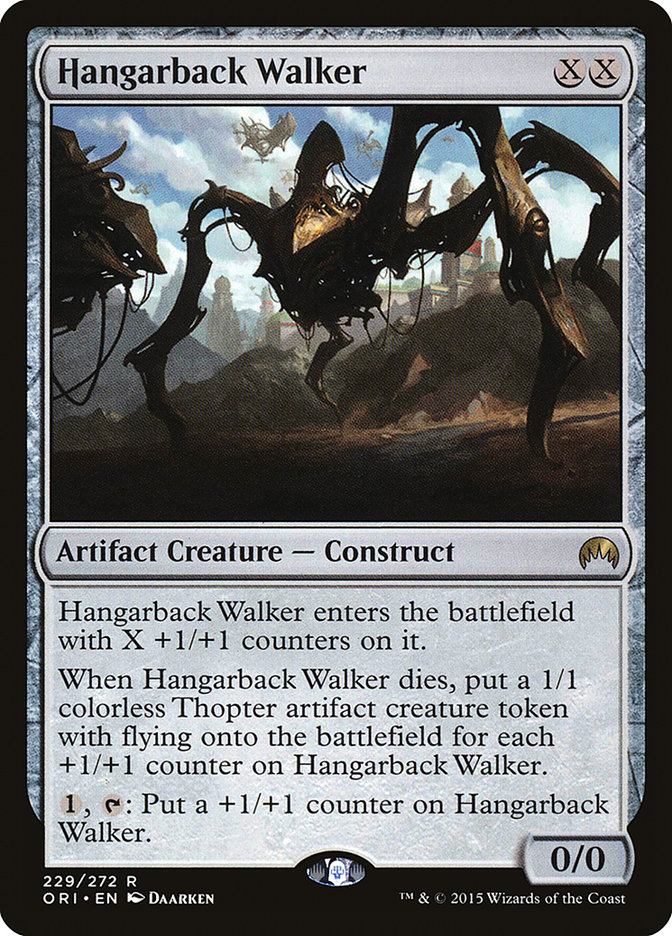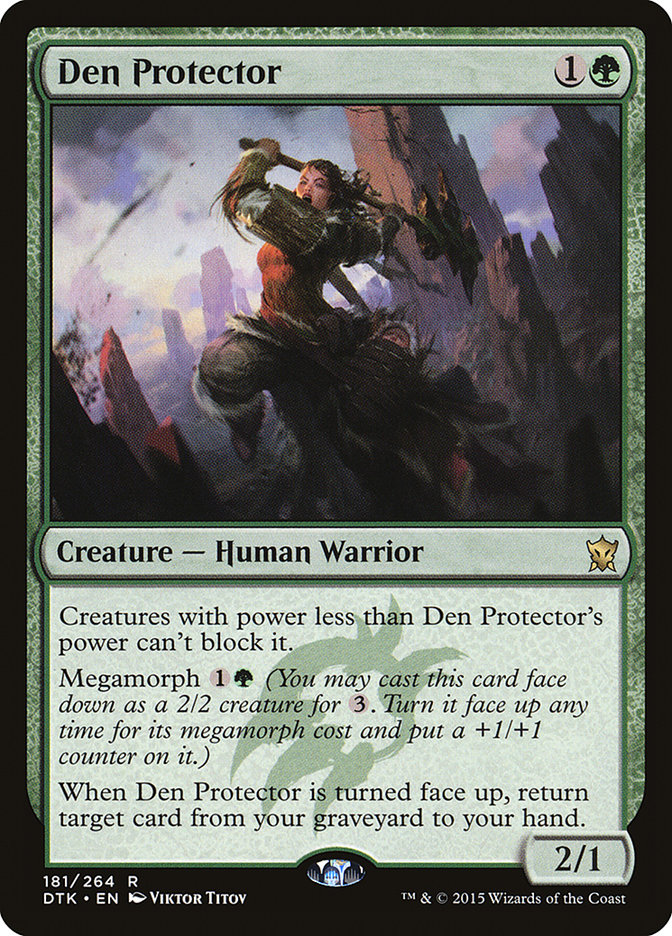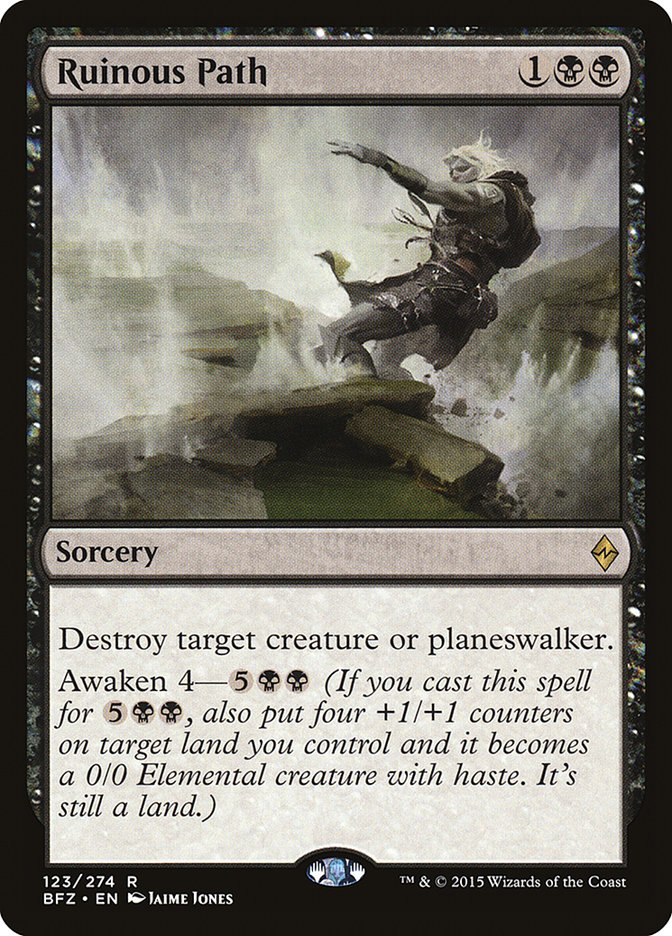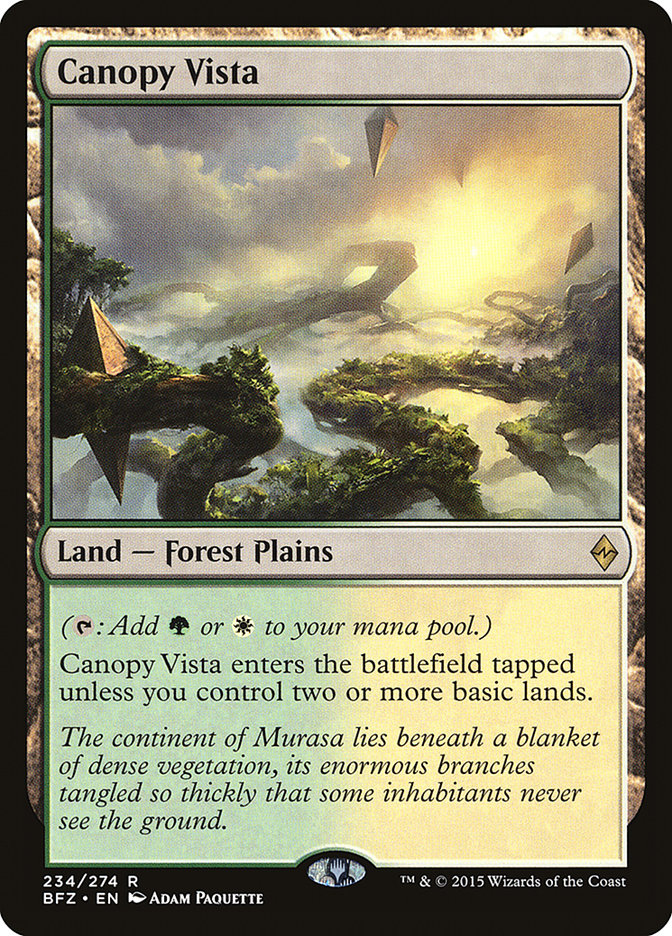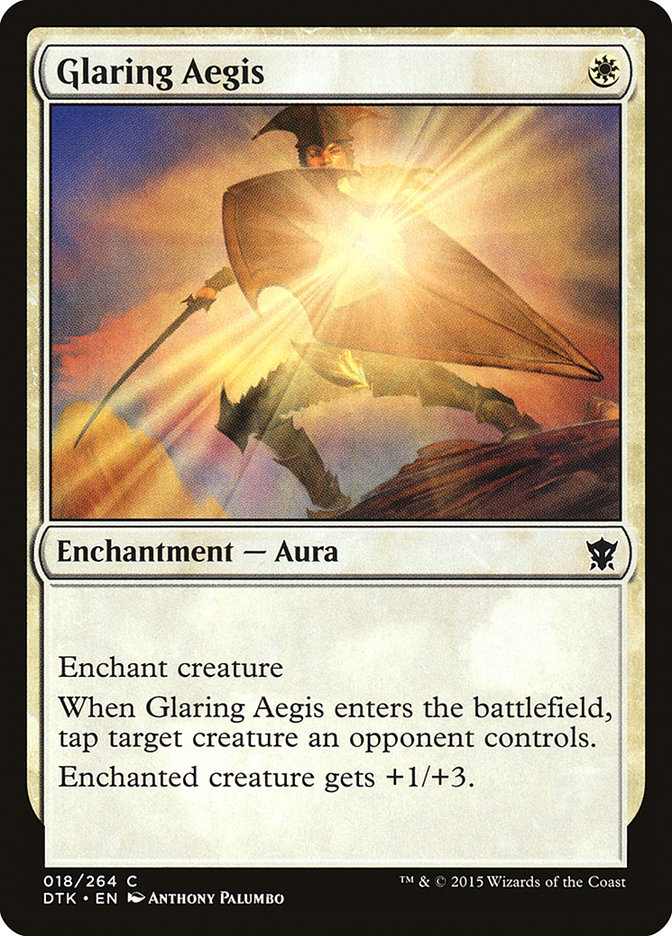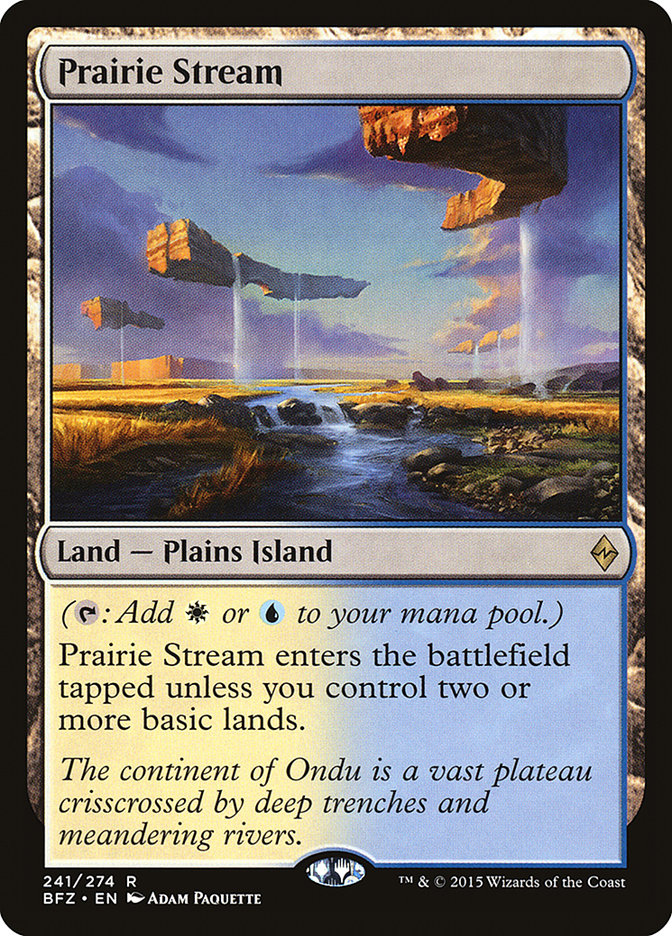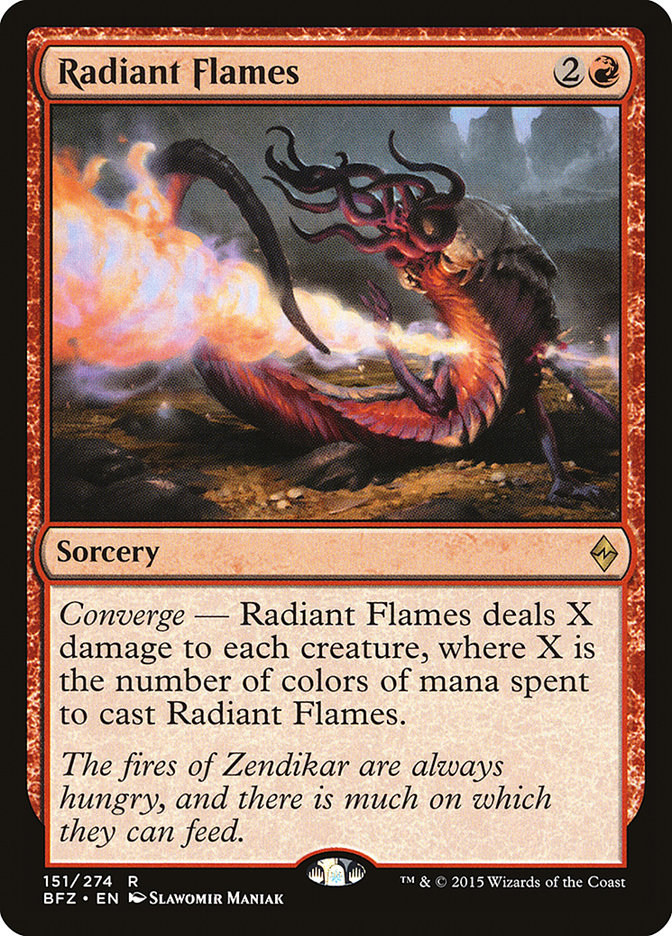Battle for Zendikar
spoiler season is upon us.
Today, I’d like to take a look at what I believe to be a stone-cold lock for one of the top five new cards of the set.
Gideon, Ally of Zendikar is that rare planeswalker that gets a lot of value out of each of its three abilities. It’s also a four-cost planeswalker priced
to move. Elspeth, Sun’s Champion is rotating out; R&D knows this and can rebalance white cards around the new world we’ll find ourselves in.
The first ability to consider for Gideon is actually his middle ability since it’s going to be the default choice unless you have a special reason to do
otherwise.
0: Put a 2/2 white Knight Ally creature token onto the battlefield under your control.
This ability is already enough to make us sit up and take notice. Compare a 2/2 token to drawing a card. In general, a 0-mana 2/2 would be too good to
print because of the potential for abuse early; however, by turn 4, a 2/2 is very close to as good as a card (in general), perhaps slightly less. That the
token is an Ally is a nice bonus since it will trigger a lot of sweet abilities in some decks. Some of the Allies in Battle for Zendikar will give
you a bonus each time you get an Ally, but you definitely don’t need them for Gideon to be an amazing deal.
The point is, this is a really strong zero ability for a four-cost planeswalker that doesn’t exactly start with a trivial amount of loyalty. The 2/2 is
great at defending Gideon, and even if someone has a removal spell for the Gideon, we’re usually going to end up ahead material because of it.
This ability is most similar to Xenagos, the Reveler; it’s just that the tokens don’t have haste. On the flipside, Xenagos only starts with three loyalty
and requires two colors. Additionally, Gideon has a lot of power tied up in the other two abilities.
+1: Until end of turn, Gideon becomes a 5/5 Human Soldier Ally with indestructible that’s still a planeswalker. Prevent all damage that would be dealt
to him that turn.
Gideon’s +1 ability is actually very exciting as well. Right off top, it means Gideon is effectively a 5/5 for four, but he also doesn’t die to sweepers
and can’t be killed by blockers. There are plenty of formats where this ability alone would be enough to get us to play Gideon (but that’s also true of
both of his other abilities!).
Gideon can’t (usually) attack the turn he comes down, but unlike most creatures that just hang back to block, he can make a 2/2 immediately. That means
we’re getting seven power across two bodies and a three-turn clock if we want it. That means Gideon hits harder than a Desecration Demon (when they can’t
even feed it).
It’s not just the speed at which Gideon can kill someone that makes him so dangerous. The threat of adding five damage at any point can make life really
awkward for opponents with planeswalkers. You might be planning on just making a 2/2 each turn, but the threat of the 5/5 rumbling is going to force
opponents to make some plays they would otherwise not want to.
Additionally, the gaining of even a single loyalty is huge. Gideon’s “ultimate” gives you a major permanent advantage that is going to be impossible for
people to get rid of under most circumstances. It’s already really exciting that you can use his ultimate the turn you play him if you want, but after a
single +1 you can actually threaten to use Gideon’s ultimate and keep him around!
-4: You get an emblem with “Creatures you control get +1/+1.”
Glorious Anthem has seen a lot of play over the years, which is effectively just this same ability. It is a mana cheaper, but people can actually destroy
it if they want. Additionally, Gideon has multiple other options to choose from.
It’s already a very potent option against removal to permanently buff all of your future creatures in exchange for your Gideon. However, to get to keep
Gideon on the battlefield is a really dramatic swing. Most of the time, if you want to pull off this play, you’re going to wait two turns, but each of the
turns is very productive.
Turn 4: Cast Gideon, 0: to make a 2/2. Now, even if they kill Gideon, you are ahead.
Turn 5: +1 Gideon and attack for seven. Not only have you hit your opponent really hard, but you now have enough loyalty to live through the ultimate.
Turn 6: -4 Gideon and now you have a permanent Anthem effect (in addition to your token) in case your opponent finds a way to get rid of Gideon in the
future. Plus, you can make 3/3s each turn if you want.
You could plus Gideon the turn you play him, but the five damage is wasted. As such, you’re generally only going to do that when your opponent has four
power fliers, four damage burn spells (like Exquisite Firecraft or Jeskai Charm), or the emblem is so valuable compared to the token that you just want to
get it as fast as possible without losing Gideon.
The three different abilities on three consecutive turns line is probably not going to be the most common, but it is a nice natural progression in terms of
the ramping up of options available to Gideon. In general, you’re probably going to keep making 2/2s or keep hitting with Gideon the turn after you make
one, with the emblem ability getting used the turn you kill your opponent or the turn you play Gideon against a slower and more reactive opponent.
One particularly exciting component of Gideon’s 2/2s (as opposed to Xenagos’s) is that even though Gideon’s loyalty isn’t going up, he is still building
towards an “ultimate.” In a stand-off, you might amass quite a collection of 2/2s, but at a moment’s notice, you can give yourself an emblem and increase
the damage on the table by 50%. If you have another Gideon in hand, it’s like you built most of an Elspeth, Sun’s Champion ultimate by surprise!
One of the big limiting factors for planeswalkers is usually the uniqueness rule, making extra copies less valuable. Gideon’s ultimate synergizes so
powerfully with other Gideons, it’s actually going to be quite strong to draw two or more Gideons in a lot decks.
Turn 4: Gideon, make a token.
Turn 5: Get an emblem, then play another Gideon and make a 3/3. Attack for three.
Turn 6: Get an emblem, then play another Gideon and make a 3/3. Attack for six.
Turn 7: Get an emblem and attack for twelve, or make Gideon a 7/7 and attack for sixteen.
This is no faster of a clock than Gideon would normally be, but you’ve got a lot to show for things if your opponent is fighting back. Additionally, this
plan works really well with creatures that cost three or less. If you have two creatures already on the battlefield:
Turn 4: Gideon, make a token.
Turn 5: Emblem, then cast another Gideon and make a token. Attack for +5 (token plus emblem buffing three creatures).
Turn 6: Attack with Gideon and your creatures for +11 (Gideon is a 6/6, token is a 3/3, plus you are buffing two other creatures).
That is a huge amount of damage since you’re also getting the damage from the base stats of the two creatures. Against an opponent that’s putting up
resistance, that’s often going to be a dominating advantage; however, you don’t even need two other creatures to be threatening a fast kill because of
Gideon. In fact, an opening hand with two Gideons, four Plains, and an off-color morph kills on turn 6 by itself!
Let’s take a look at some of the possible homes for Gideon (also known as white decks):
Creatures (16)
Planeswalkers (5)
Lands (26)
Spells (13)

Abzan is the perfect place to start with any insane rate white, black, or green card, and Gideon fits in nicely. It can be a part of a grindy-card
advantage battle, but it can also hit like a truck when you’re on the smash people and Siege Rhino plan.
Hangarback Walker is just an incredibly strong Magic card in its own right, but the synergy with Gideon is too good to ignore. Dromoka’s Command is an easy
way to kill off your Hangarback Walker (not to mention just casting a sweeper). Gideon’s emblem absolutely loves an army of 1/1 fliers to power up!
I’m not sure how important enchantment removal will be in the new world, but Dromoka’s Command is a pretty solid card anyway. It’s amusing to consider
Dromoka’s Command against Virulent Plague, but the Plague doesn’t actually stop Gideon as well as it seems like it should. First of all, Gideon’s emblem
brings the token-making ability back online, and Gideon can still attack for five a turn.
Den Protector is another card that is very powerful on her own, but she is especially important in the new Gideon world. Gideon’s emblem makes Den
Protector even harder to block, plus he just works great with creatures that like attacking while also grinding out card advantage.
Den Protector is also quite strong against Gideon since her megamorph ability makes opposing Gideon tokens unable to block, and it can usually kill Gideon
in two hits. Of course, a second Gideon can really turn the tides since the first Gideon can make an emblem. Now, the second Gideon tokens can actually
stop the Den Protector (unless you have a Gideon of your own!).
With Hero’s Downfall rotating out, there is a huge vacuum that needs to be filled for reliable, versatile removal. Ruinous Path is a compelling place to
start since it is basically a Hero’s Downfall slowed down to sorcery speed in exchange for having, “kicker 4 turn one of your lands into a 4/4 creature.”
With eight mana you can attack with the creature that turn.
At first glance, the card seems slightly worse to me than Hero’s Downfall, as instant speed really is great; however, the card is “more powerful.” When the
game goes long, it gives you another threat with very little opportunity cost. That it can kill a creature and add four damage out of nowhere is a nice way
to support the Siege Rhino plan. It’s also sweet that the lands it awakens are colorless creatures, so they live through Ugin’s abilities.
It’s kind of interesting just how many +1/+1 counters the Awaken mechanic is going to be adding to the board sometimes. I’m curious to see the impact this
has on cards like Avatar of the Resolute and Gleam of Authority.
The new BFZ dual lands are totally fine, but they are nowhere near the power level of Temples. Because they need two basics to get the free untap, they are
generally going to be better in two-color decks that can afford to play a lot of basics or in three-color “shards” (not the Khans “wedges”) since you get
two sets of fetchlands.
The loss of ten Temples is a major shift in the balance of power, particularly since the new dual lands are only the friendly color combinations. That
means it’s temporarily harder to play enemy color combinations, and without Mana Confluence, we’re going to see more Evolving Wilds and more two-color
decks.
Of course, the set after Battle for Zendikar seems like it will have enemy manlands. The format is a set of enemy duals short of what it should
have, and the original Zendikar expansion, Worldwake, had immensely popular friendly manlands.
Even with Fleecemane Lion rotating out, it’s possible that we might want to be more aggressive with our Abzan deck. Here’s an attempt at Abzan Aggro:
Creatures (20)
- 4 Anafenza, the Foremost
- 2 Wingmate Roc
- 4 Siege Rhino
- 2 Seeker of the Way
- 4 Den Protector
- 4 Hangarback Walker
Planeswalkers (4)
Lands (26)
Spells (10)

I’m not sure at all about Seeker of the Way, but we need another two-drop and Rakshasa Deathdealer seems painful to cast. To try to make the mana work more
reliably, this list doesn’t even play Ruinous Path maindeck (meaning no double black or double green in the starting 60).
Normally, I would want to play more than two Wingmate Rocs in a deck like this. Gideon is such a great way to make Anafenza and Wingmate Roc beat Languish
(and in fact, makes me less interested in Languish in control decks than I normally would be). However, the use of four Siege Rhinos and four Gideons means
we’re already a little heavy on slower stuff.
Why not play less than four Gideons?
Maybe. I just think the card looks insane, and drawing two copies seems like it might be better than drawing one and a random card. I feel like we’ll learn
more starting with the high end.
The loss of Temples provides added incentive to play two-color decks. What if we played straight Orzhov?
Creatures (15)
- 4 Knight of the White Orchid
- 4 Seeker of the Way
- 2 Sidisi, Undead Vizier
- 1 Ojutai Exemplars
- 4 Hangarback Walker
Planeswalkers (5)
Lands (26)
Spells (14)

The coolest part about this list is the use of Sidisi, Undead Vizier + Hangarback Walker. I’m really excited to see how we might be able to exploit Hangarback Walker as a sacrificial offering. A lot of people are willing to pay to kill their Hangarbacks, so getting to sacrifice it to
pay for a cost is super sweet.
Of course, the loss of Temple of Silence without an immediate replacement initially makes two-color enemy decks less appealing. We’re playing more than a
couple “off-color” tri-lands, just to serve as more tapped duals. Assuming we get enemy manlands in the set after this, that’s going to really change the
landscape. For now, however, there are some serious constraints on what manabases we can realistically play. For instance, enemy two-color aggro decks have
pretty horrible looking manabases. Here’s an example of what I mean:
Creatures (25)
- 2 Chief of the Scale
- 4 Chief of the Edge
- 4 Bloodsoaked Champion
- 4 Mardu Woe-Reaper
- 1 Hidden Dragonslayer
- 4 Arashin Foremost
- 2 Blood-Chin Rager
- 4 Dragon Hunter
Planeswalkers (4)
Lands (24)
Spells (7)

This “aggro” deck has 24 land, including a bunch of tapped lands. It’s also going to have more difficulty casting its creatures on curve than I would like.
If we want to reliably curve out earlier, we are probably going to want to look at mono-color decks first. For instance:
Creatures (25)
- 4 Knight of the White Orchid
- 4 Wingmate Roc
- 4 Mardu Woe-Reaper
- 2 Hidden Dragonslayer
- 2 Anafenza, Kin-Tree Spirit
- 3 Kytheon, Hero of Akros
- 2 Archangel of Tithes
- 4 Hangarback Walker
Planeswalkers (4)
Lands (24)
Spells (7)

I started out with a lower curve, trying to get more out of Gideon’s emblem, however, the one-drops are just not that exciting. We’re also getting
screwed up at the three-spot anyway. White has almost nothing to offer at the three-spot, though it is nice that Knight of the White Orchid and Hidden
Dragonslayer make good three-drops. We are also planning on playing Hangarback on two and then using it on three, leaving us enough mana to cast another
two-drop.
If we wanted to get a lot more aggressive, we could try using stuff like Glaring Aegis to help force through Consul’s Lieutenant. If we find a few one-mana
plays we like, it can help make up for the lack of threes by letting us play a one and a two in the same turn.
While we are temporarily discouraged from enemy two-color decks, there is extra incentive to look at allied two-color decks. What if we replaced the black
from above with blue?
Creatures (10)
Planeswalkers (4)
Lands (26)
Spells (20)

It could very well be crazy to not play the full playset of Gideons. Multiple Gideons is a little worse without Hangarback Walker. We could add Walkers, of
course, but one of the draws for U/W is Ojutai’s Command. Jace, Vryn’s Prodigy is the primary target to return, but Soulfire Grand Master is a nice target
too. Hangarback Walker normally doesn’t work that great with the Command (coming back as a 0/0); however, Gideon’s emblem actually makes this combo legit.
The Walker comes back as a 1/1, then can start gaining counters.
This is the perfect deck for the new dual lands. Not only do we have a ton of basics (twelve counting Flooded Strand), we also really appreciate having our
third, fourth, fifth, or even eighth mana come into play untapped.
I had been sketching out an Esper Control deck, but I’m not sure what black would actually offer that white doesn’t already. Eventually, my list just
turned into an Esper Dragons deck, which isn’t even really white. This meant no Gideons, but here’s the list anyway:
Creatures (10)
Planeswalkers (1)
Lands (26)
Spells (23)

The loss of two-mana removal hurts, particularly alongside the loss of Thoughtseize, but at least we have Hangarback Walker to help ease the pain.
While the Khans wedges have lost some of their mana stability, the tri-lands ensure there’s still enough to make them all work (though I would probably be
hesitant to play double color cards of all three).
Here’s a look at Jeskai:
Creatures (8)
Planeswalkers (4)
Lands (25)
Spells (23)

Gideon is absolutely awesome in Jeskai Tokens. It’s a source of tokens, of course, but the emblem is just crazy good here. The +1/+1 makes all of our token
generators big threats, but I just like getting a double bonus (the Ascendancy trigger and then the emblem itself).
Radiant Flames is the new format’s answer to Anger of the Gods rotating out. It’s mainly a three-color card, but it is interesting that you might be able
to backdoor the third color off of some tri-lands in your two-color deck.
Dealing three damage to everything for three mana is already interesting, particularly since it only requires single red. It’s also interesting the
prospect of intentionally only dealing two damage, for instance when sideboarding in Arashin Clerics.
Since we want to try Gideon in every conceivable white deck, we might as well take a look at Mardu.
Creatures (17)
Planeswalkers (4)
Lands (25)
Spells (14)

This list doesn’t look particularly enticing to me; however, I do like the idea of playing Butcher of the Horde in a world where everyone else is playing
Gideon on four. Butcher of the Horde is also an excellent way to sacrifice Hangarback Walker, and it loves having a renewable source of food, like Gideon.
With just 41 of the 274 Battle for Zendikar cards spoiled, it’s much too early to tell what the new format is going to look like. However, it’s
not too early to start brainstorming with the post-rotation world so that we have a better idea of what to look for in the new set. Understanding the
context these cards will be living in is super valuable for figuring out what direction the format is going and which cards will define the format.
As for Gideon?
Verdict: All-Star, Flagship, Pillar of the Format


